逻辑回归代码demo
程序所用文件:https://files.cnblogs.com/files/henuliulei/%E5%9B%9E%E5%BD%92%E5%88%86%E7%B1%BB%E6%95%B0%E6%8D%AE.zip
概念
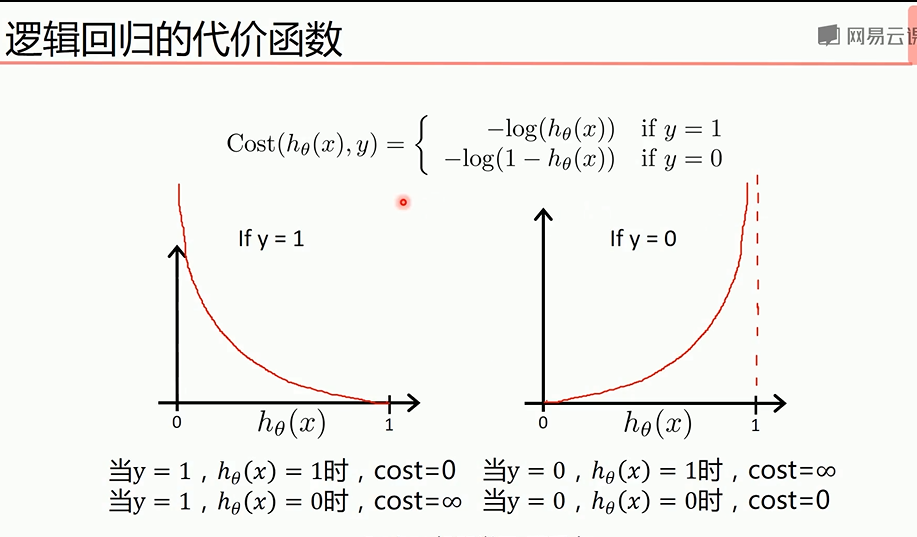
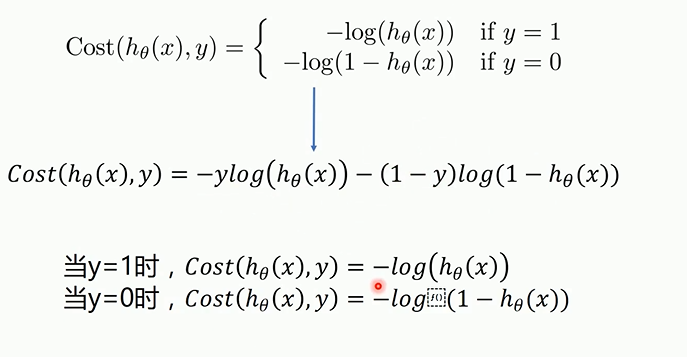
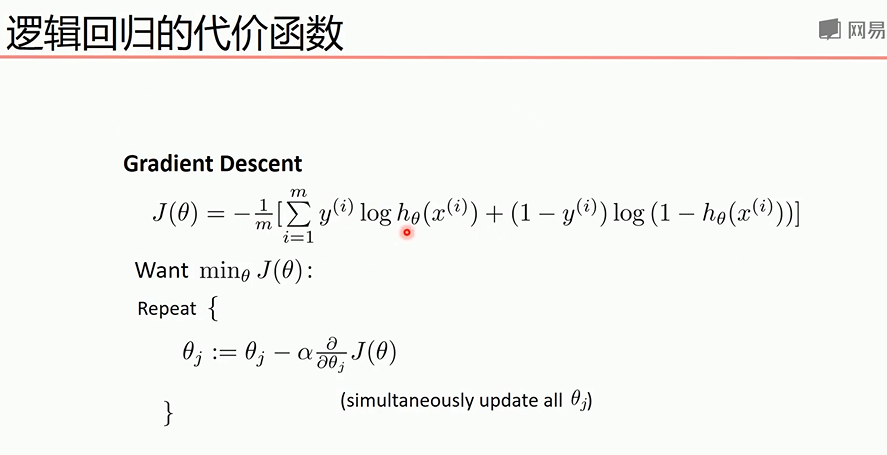
代价函数关于参数的偏导
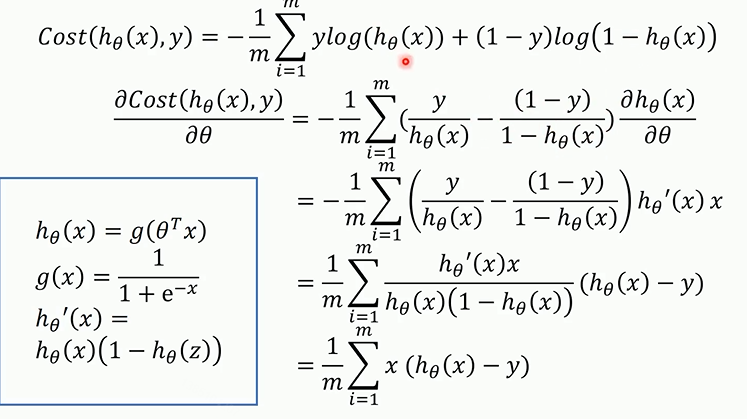
梯度下降法最终的推导公式如下
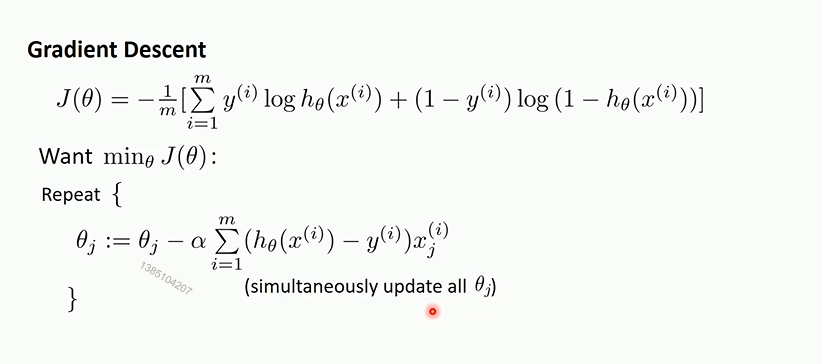
多分类问题可以转为2分类问题
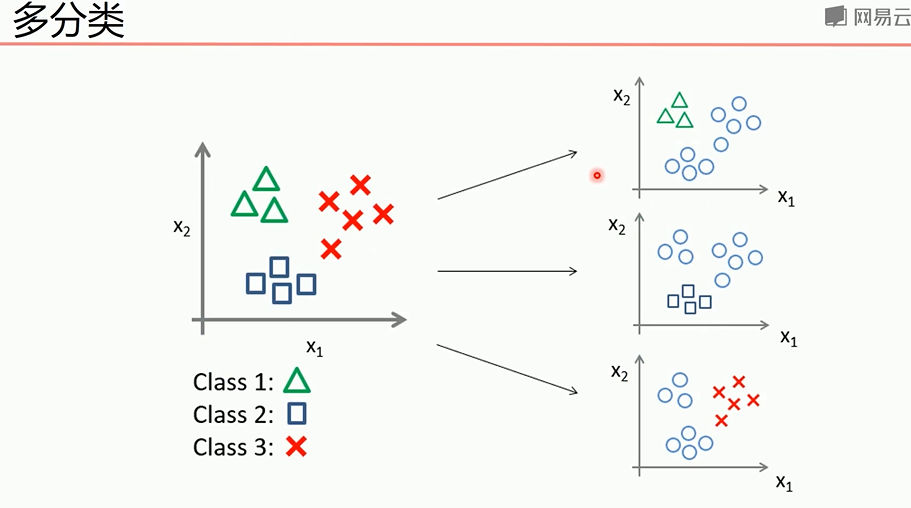
正则化处理可以防止过拟合,下面是正则化后的代价函数和求导后的式子
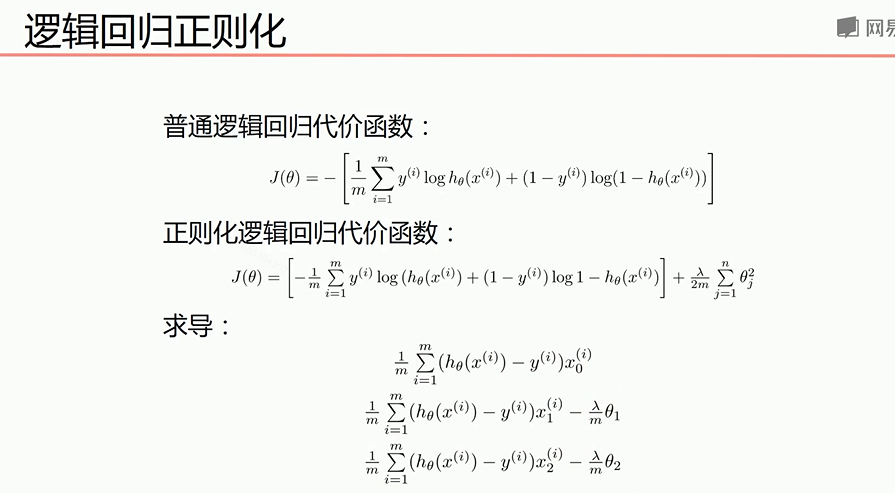
正确率和召回率F1指标
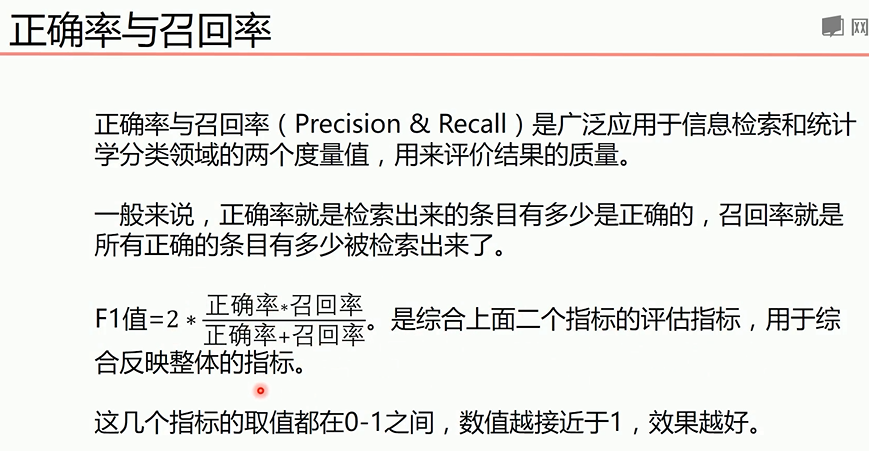

我们希望自己预测的结果希望更准确那么查准率就更高,如果希望更获得更多数量的正确结果,那么查全率更重要,综合考虑可以用F1指标
梯度下降法实现线性逻辑回归
import matplotlib.pyplot as plt
import numpy as np
from sklearn.metrics import classification_report#分类
from sklearn import preprocessing#预测
# 数据是否需要标准化
scale = True#True是需要,False是不需要,标准化后效果更好,标准化之前可以画图看出可视化结果
scale = False
# 载入数据
data = np.genfromtxt("LR-testSet.csv", delimiter=",")
x_data = data[:, :-]
y_data = data[:, -] def plot():
x0 = []
x1 = []
y0 = []
y1 = []
# 切分不同类别的数据
for i in range(len(x_data)):
if y_data[i] == :
x0.append(x_data[i, ])
y0.append(x_data[i, ])
else:
x1.append(x_data[i, ])
y1.append(x_data[i, ]) # 画图
scatter0 = plt.scatter(x0, y0, c='b', marker='o')
scatter1 = plt.scatter(x1, y1, c='r', marker='x')
# 画图例
plt.legend(handles=[scatter0, scatter1], labels=['label0', 'label1'], loc='best') plot()
plt.show()
# 数据处理,添加偏置项
x_data = data[:,:-]
y_data = data[:,-,np.newaxis] print(np.mat(x_data).shape)
print(np.mat(y_data).shape)
# 给样本添加偏置项
X_data = np.concatenate((np.ones((,)),x_data),axis=)
print(X_data.shape) def sigmoid(x):
return 1.0 / ( + np.exp(-x)) def cost(xMat, yMat, ws):
left = np.multiply(yMat, np.log(sigmoid(xMat * ws)))
right = np.multiply( - yMat, np.log( - sigmoid(xMat * ws)))
return np.sum(left + right) / -(len(xMat)) def gradAscent(xArr, yArr):
if scale == True:
xArr = preprocessing.scale(xArr)
xMat = np.mat(xArr)
yMat = np.mat(yArr) lr = 0.001
epochs =
costList = []
# 计算数据行列数
# 行代表数据个数,列代表权值个数
m, n = np.shape(xMat)
# 初始化权值
ws = np.mat(np.ones((n, ))) for i in range(epochs + ):
# xMat和weights矩阵相乘
h = sigmoid(xMat * ws)
# 计算误差
ws_grad = xMat.T * (h - yMat) / m
ws = ws - lr * ws_grad if i % == :
costList.append(cost(xMat, yMat, ws))
return ws, costList
# 训练模型,得到权值和cost值的变化
ws,costList = gradAscent(X_data, y_data)
print(ws)
if scale == False:
# 画图决策边界
plot()
x_test = [[-],[]]
y_test = (-ws[] - x_test*ws[])/ws[]
plt.plot(x_test, y_test, 'k')
plt.show()
# 画图 loss值的变化
x = np.linspace(, , )
plt.plot(x, costList, c='r')
plt.title('Train')
plt.xlabel('Epochs')
plt.ylabel('Cost')
plt.show()
# 预测
def predict(x_data, ws):
if scale == True:
x_data = preprocessing.scale(x_data)
xMat = np.mat(x_data)
ws = np.mat(ws)
return [ if x >= 0.5 else for x in sigmoid(xMat*ws)] predictions = predict(X_data, ws) print(classification_report(y_data, predictions))#计算预测的分
sklearn实现线性逻辑回归
import matplotlib.pyplot as plt
import numpy as np
from sklearn.metrics import classification_report
from sklearn import preprocessing
from sklearn import linear_model
# 数据是否需要标准化
scale = False
# 载入数据
data = np.genfromtxt("LR-testSet.csv", delimiter=",")
x_data = data[:, :-]
y_data = data[:, -] def plot():
x0 = []
x1 = []
y0 = []
y1 = []
# 切分不同类别的数据
for i in range(len(x_data)):
if y_data[i] == :
x0.append(x_data[i, ])
y0.append(x_data[i, ])
else:
x1.append(x_data[i, ])
y1.append(x_data[i, ]) # 画图
scatter0 = plt.scatter(x0, y0, c='b', marker='o')
scatter1 = plt.scatter(x1, y1, c='r', marker='x')
# 画图例
plt.legend(handles=[scatter0, scatter1], labels=['label0', 'label1'], loc='best') plot()
plt.show()
logistic = linear_model.LogisticRegression()
logistic.fit(x_data, y_data)
if scale == False:
# 画图决策边界
plot()
x_test = np.array([[-],[]])
y_test = (-logistic.intercept_ - x_test*logistic.coef_[][])/logistic.coef_[][]
plt.plot(x_test, y_test, 'k')
plt.show()
predictions = logistic.predict(x_data) print(classification_report(y_data, predictions))
梯度下降法实现非线性逻辑回归
import matplotlib.pyplot as plt
import numpy as np
from sklearn.metrics import classification_report
from sklearn import preprocessing
from sklearn.preprocessing import PolynomialFeatures
# 数据是否需要标准化
scale = False
# 载入数据
data = np.genfromtxt("LR-testSet2.txt", delimiter=",")
x_data = data[:, :-]
y_data = data[:, -, np.newaxis] def plot():
x0 = []
x1 = []
y0 = []
y1 = []
# 切分不同类别的数据
for i in range(len(x_data)):
if y_data[i] == :
x0.append(x_data[i, ])
y0.append(x_data[i, ])
else:
x1.append(x_data[i, ])
y1.append(x_data[i, ])
# 画图
scatter0 = plt.scatter(x0, y0, c='b', marker='o')
scatter1 = plt.scatter(x1, y1, c='r', marker='x')
# 画图例
plt.legend(handles=[scatter0, scatter1], labels=['label0', 'label1'], loc='best') plot()
plt.show()
# 定义多项式回归,degree的值可以调节多项式的特征
poly_reg = PolynomialFeatures(degree=)
# 特征处理
x_poly = poly_reg.fit_transform(x_data)
def sigmoid(x):
return 1.0 / ( + np.exp(-x)) def cost(xMat, yMat, ws):
left = np.multiply(yMat, np.log(sigmoid(xMat * ws)))
right = np.multiply( - yMat, np.log( - sigmoid(xMat * ws)))
return np.sum(left + right) / -(len(xMat)) def gradAscent(xArr, yArr):
if scale == True:
xArr = preprocessing.scale(xArr)
xMat = np.mat(xArr)
yMat = np.mat(yArr) lr = 0.03
epochs =
costList = []
# 计算数据列数,有几列就有几个权值
m, n = np.shape(xMat)
# 初始化权值
ws = np.mat(np.ones((n, ))) for i in range(epochs + ):
# xMat和weights矩阵相乘
h = sigmoid(xMat * ws)
# 计算误差
ws_grad = xMat.T * (h - yMat) / m
ws = ws - lr * ws_grad if i % == :
costList.append(cost(xMat, yMat, ws))
return ws, costList
# 训练模型,得到权值和cost值的变化
ws,costList = gradAscent(x_poly, y_data)
print(ws) # 获取数据值所在的范围
x_min, x_max = x_data[:, ].min() - , x_data[:, ].max() +
y_min, y_max = x_data[:, ].min() - , x_data[:, ].max() + # 生成网格矩阵
xx, yy = np.meshgrid(np.arange(x_min, x_max, 0.02),
np.arange(y_min, y_max, 0.02))
#print(xx.shape)#xx和yy有相同shape,xx的每行相同,总行数取决于yy的范围
#print(yy.shape)#xx和yy有相同shape,yy的每列相同,总行数取决于xx的范围
# np.r_按row来组合array,
# np.c_按colunm来组合array
# >>> a = np.array([,,])
# >>> b = np.array([,,])
# >>> np.r_[a,b]
# array([, , , , , ])
# >>> np.c_[a,b]
# array([[, ],
# [, ],
# [, ]])
# >>> np.c_[a,[,,],b]
# array([[, , ],
# [, , ],
# [, , ]])
z = sigmoid(poly_reg.fit_transform(np.c_[xx.ravel(), yy.ravel()]).dot(np.array(ws)))# ravel与flatten类似,多维数据转一维。flatten不会改变原始数据,ravel会改变原始数据
for i in range(len(z)):
if z[i] > 0.5:
z[i] =
else:
z[i] =
print(z)
z = z.reshape(xx.shape) # 等高线图
cs = plt.contourf(xx, yy, z)
plot()
plt.show()
# 预测
def predict(x_data, ws):
# if scale == True:
# x_data = preprocessing.scale(x_data)
xMat = np.mat(x_data)
ws = np.mat(ws)
return [ if x >= 0.5 else for x in sigmoid(xMat*ws)] predictions = predict(x_poly, ws) print(classification_report(y_data, predictions))
sklearn实现非线性逻辑回归
import numpy as np
import matplotlib.pyplot as plt
from sklearn import linear_model
from sklearn.datasets import make_gaussian_quantiles
from sklearn.preprocessing import PolynomialFeatures
# 生成2维正态分布,生成的数据按分位数分为两类,500个样本,2个样本特征
# 可以生成两类或多类数据
x_data, y_data = make_gaussian_quantiles(n_samples=, n_features=,n_classes=)#生成500个样本,2个特征,2个类别
plt.scatter(x_data[:, ], x_data[:, ], c=y_data)
plt.show()
logistic = linear_model.LogisticRegression()
logistic.fit(x_data, y_data)
# 获取数据值所在的范围
x_min, x_max = x_data[:, ].min() - , x_data[:, ].max() +
y_min, y_max = x_data[:, ].min() - , x_data[:, ].max() +
# 生成网格矩阵
xx, yy = np.meshgrid(np.arange(x_min, x_max, 0.02),
np.arange(y_min, y_max, 0.02))
z = logistic.predict(np.c_[xx.ravel(), yy.ravel()])# ravel与flatten类似,多维数据转一维。flatten不会改变原始数据,ravel会改变原始数据
z = z.reshape(xx.shape)
# 等高线图
cs = plt.contourf(xx, yy, z)
# 样本散点图
plt.scatter(x_data[:, ], x_data[:, ], c=y_data)
plt.show()
print('score:',logistic.score(x_data,y_data))#使用线性逻辑回归,得分很低 # 定义多项式回归,degree的值可以调节多项式的特征
poly_reg = PolynomialFeatures(degree=)
# 特征处理
x_poly = poly_reg.fit_transform(x_data)
# 定义逻辑回归模型
logistic = linear_model.LogisticRegression()
# 训练模型
logistic.fit(x_poly, y_data) # 获取数据值所在的范围
x_min, x_max = x_data[:, ].min() - , x_data[:, ].max() +
y_min, y_max = x_data[:, ].min() - , x_data[:, ].max() + # 生成网格矩阵
xx, yy = np.meshgrid(np.arange(x_min, x_max, 0.02),
np.arange(y_min, y_max, 0.02))
z = logistic.predict(poly_reg.fit_transform(np.c_[xx.ravel(), yy.ravel()]))# ravel与flatten类似,多维数据转一维。flatten不会改变原始数据,ravel会改变原始数据
z = z.reshape(xx.shape)
# 等高线图
cs = plt.contourf(xx, yy, z)
# 样本散点图
plt.scatter(x_data[:, ], x_data[:, ], c=y_data)
plt.show()
print('score:',logistic.score(x_poly,y_data))#得分很高
逻辑回归代码demo的更多相关文章
- [DL] 基于theano.tensor.dot的逻辑回归代码中的SGD部分的疑问探幽
在Hinton的教程中, 使用Python的theano库搭建的CNN是其中重要一环, 而其中的所谓的SGD - stochastic gradient descend算法又是如何实现的呢? 看下面源 ...
- 逻辑回归原理(python代码实现)
Logistic Regression Classifier逻辑回归主要思想就是用最大似然概率方法构建出方程,为最大化方程,利用牛顿梯度上升求解方程参数. 优点:计算代价不高,易于理解和实现. 缺点: ...
- Spark Mllib逻辑回归算法分析
原创文章,转载请注明: 转载自http://www.cnblogs.com/tovin/p/3816289.html 本文以spark 1.0.0版本MLlib算法为准进行分析 一.代码结构 逻辑回归 ...
- 【原】Coursera—Andrew Ng机器学习—编程作业 Programming Exercise 3—多分类逻辑回归和神经网络
作业说明 Exercise 3,Week 4,使用Octave实现图片中手写数字 0-9 的识别,采用两种方式(1)多分类逻辑回归(2)多分类神经网络.对比结果. (1)多分类逻辑回归:实现 lrCo ...
- 机器学习/逻辑回归(logistic regression)/--附python代码
个人分类: 机器学习 本文为吴恩达<机器学习>课程的读书笔记,并用python实现. 前一篇讲了线性回归,这一篇讲逻辑回归,有了上一篇的基础,这一篇的内容会显得比较简单. 逻辑回归(log ...
- 逻辑回归(Logistic Regression)详解,公式推导及代码实现
逻辑回归(Logistic Regression) 什么是逻辑回归: 逻辑回归(Logistic Regression)是一种基于概率的模式识别算法,虽然名字中带"回归",但实际上 ...
- python sklearn库实现逻辑回归的实例代码
Sklearn简介 Scikit-learn(sklearn)是机器学习中常用的第三方模块,对常用的机器学习方法进行了封装,包括回归(Regression).降维(Dimensionality Red ...
- Iris花逻辑回归与实现
Iris花的分类是经典的逻辑回归的代表:但是其代码中包含了大量的python库的核心处理模式,这篇文章就是剖析python代码的文章. #取用下标为2,3的两个feture,分别是花的宽度和长度: # ...
- 用R做逻辑回归之汽车贷款违约模型
数据说明 本数据是一份汽车贷款违约数据 application_id 申请者ID account_number 账户号 bad_ind 是否违约 vehicle_year ...
随机推荐
- AT指令集之Call
1.//unsolicited result code,URC表示BP->AP+ESIPCPI:<call_id>,<dir>,<sip_msg_type>, ...
- Android Telephony分析(一) ---- Phone详解
目录: Phone的继承关系与PhoneFactory(GsmCdmaPhone.ImsPhone.SipPhone) Phone进程的启动 Phone对象的初始化(DefaultPhoneNotif ...
- jdbc_mysql----interset
- ElasticSearch 增删改查
HTTP 协议本身语义:GET 获取资源.POST 新建资源(也可以用于更新资源).PUT 更新资源.DELETE 删除资源. ES通过HTTP Restful方式管理数据:1.格式:#操作 /ind ...
- await和async
using System; using System.Collections.Generic; using System.Linq; using System.Text; using System.T ...
- SSM项目配置文件DEMO
SSM相关配置文件 <spring-mvc.xml>文件 <?xml version="1.0" encoding="UTF-8"?> ...
- 重写(Overriding)和重载(Overloading)
方法的重写(Overriding)和重载(Overloading)是java多态性的不同表现,重写是父类与子类之间多态性的一种表现,重载可以理解成多态的具体表现形式. (1)方法重载是一个类中定义了多 ...
- CF886F Symmetric Projections
题意:给你平面上n个点,问有多少条过原点的直线,使得这些点在该直线上的投影(做垂直,对应点)形成对称图形?n<=2000. 标程: #include<bits/stdc++.h> # ...
- redis笔记_源码_字典dict
参考:https://redissrc.readthedocs.io/en/latest/datastruct/dict.html Expand: 条件: 新的table 大小: Rehash: 条件 ...
- 为什么串行传输时总是LSB在前?
https://superuser.com/questions/1104212/why-do-serial-ports-send-data-least-significant-bit-first 其实 ...
